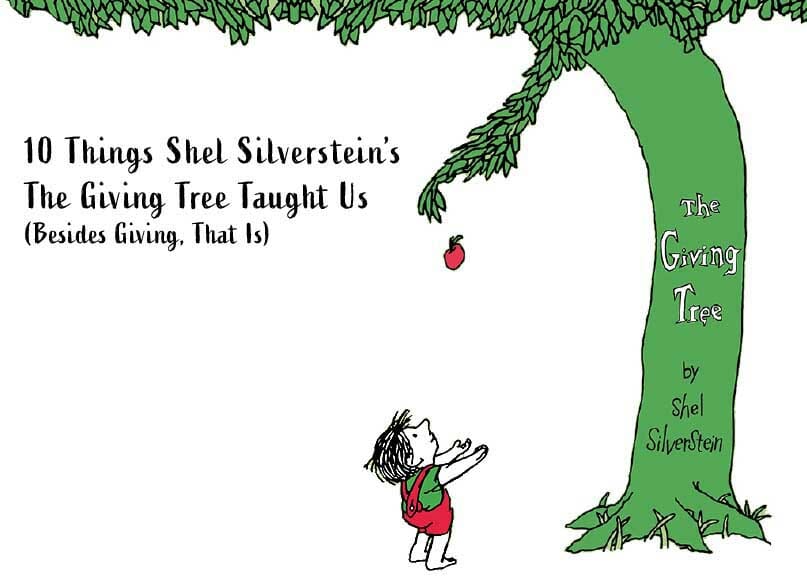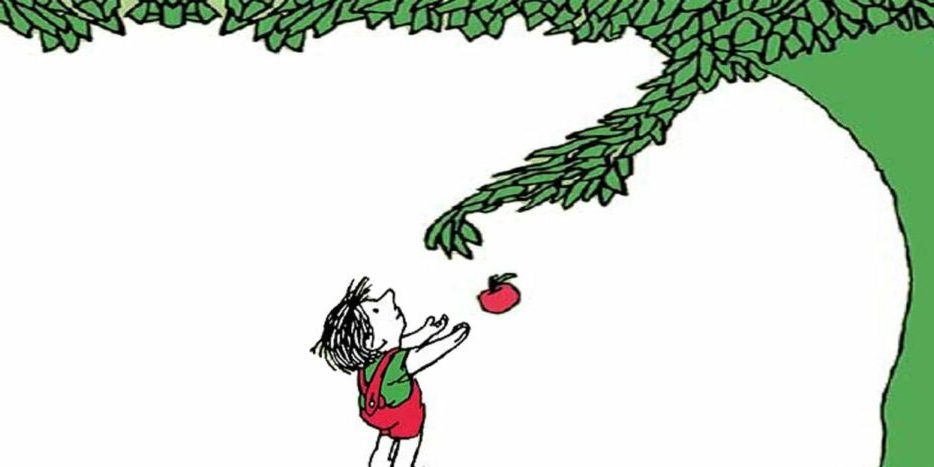by Whitney Collins, adapted by Dr. Mary Ann Shallcross Smith


This slight, leaf-green volume has since become the perfect baby gift, a library mainstay, and a classroom cornerstone, because it teaches—most outwardly—the wonderful lesson of generosity. But is there more to it than that? Scholars have long debated (sometimes quite heatedly) what The Giving Tree seeks to impart to its readers beyond unselfishness. Some say it’s actually the story of God and humankind, or Mother Nature and society, or the classic parent-child relationship, or unrequited romantic love. Some believe it’s a book of adult satire, while others write it off as unbearably sad. Others believe it’s a fable about life and life lessons—of what it means to be mortal and flawed, and ultimately enlightened and wise. So, in that vein, here are 10 additional lessons Silverstein’s most heartfelt title teaches us, on top of unconditional charity.
1. Don’t Keep Score
Humans are naturally concerned with fairness, justice, and equality—especially when it comes to themselves. Not tallying things up is one hard lesson for us needy people to learn, but The Giving Tree teaches it so well. She gives and gives and gives, never expecting anything in return, never asking for her due, never REMINDING the Boy of all she has sacrificed. It’s not martyrdom, it’s just unchecked altruism. In her infinite wisdom, the Tree knows nothing is ever really lost or gained, neither scientifically nor spiritually, so what’s the point in accurate accounting?
2. Go Barefoot
What are those things you’re wearing? Stilettos? Unforgiving loafers? Steel-toed boots? Well, take off those podiatric prisons and get your poor bunions into some sand or grass or mud ASAP! In The Giving Tree, you’ll notice that The Boy is almost always barefoot—that is, until the temptations of the material world come calling, convincing him to pull himself up by his bootstraps and head into the Big Apple.


3. You Can’t Outrun (Or Out-Canoe) Your Problems
Life is hard and complicated. So is facing your fears and regrets and wildest dreams and death. But if you ever find yourself so distraught with your predicament that you are willing to go barreling out to sea in a crude canoe, it’s time to surrender. This penultimate request from the Boy (for the Tree’s whole trunk!) always struck me as the saddest, the most rock bottom-est moment of the book, and Shel illustrated the hopelessness so well. The lesson here is a good one: don’t fight the waves in a desperate vessel. Let them crash over you before you destroy what you hold most dear. Remember: giving in isn’t giving up.
4. Just Cool It
What’s all this hustle and bustle? What’s this rat race? Sit down! Be still. And don’t get up until you’ve forgotten what all the fuss was about.
5. Focus More On What You Need Than What You Want
An orchard sounds more prestigious than a single tree. The whole, wide world seems more exciting than your own backyard. And who wouldn’t want to actually be king instead of just pretending to be one? All of us, really. But to quote a Finnish proverb, “Happiness is a place between too little and too much.” Unfortunately, the Boy learns this truth the hard way. After striving for too much of what he wants, he’s left with too little of what he needs.
6. Just Be There
Comforting someone who’s down and out isn’t easy. What do we say to make them feel better? What advice do we give? Do we take them out for ice cream? Do we order pizza? Why isn’t this distraught person being more specific about how I can help them? Well, sometimes the best thing we can do for a loved one who’s sad is just to be there. Silent and present. A constant. That’s what the Tree does for the Boy in the end. She’s just there for him. Next to him. Keeping him from feeling alone. How beautiful is that?
7. Say Please And Thank You


This is the one thing the Boy never does in The Giving Tree, and I think it’s at the root (pun intended) of his discontent. Do you know the magic words? Good, now use them!
8. A Picture’s Worth A Thousand Words
Shel Silverstein has a way of drawing that perfectly captures the human condition in all its frailty and charm and filth and weirdness. His big volumes of poetry are full of especially wacky characters and far-fetched scenarios, but The Giving Tree exudes a unique brand of simplicity. Every line is fraught with emotion, whether it’s the innocence of an untied shoelace or the stunned vacancy of The Boy’s lined face as he ages, or teeny bare toes wrapped around a tree trunk. From trench coat to crudely carved initials to that final, powerful image of a tiny broken man on a tiny broken tree, Shel’s illustrations speak louder than words. And considering how he writes, that’s saying something. You know, by not really saying something.
9. Let Love Rule
You probably think that the Tree got the raw deal in this book. That love really isn’t the answer, because, hey! Just look where unconditional love got her. Well, let me counter by saying: Just look where not-loving got the Boy. If everyone just acted on love instead of fear, we’d be a lot better off. We’d have each other and our branches and none of our shoes and all of the apples and houses NOT made of twigs. Now doesn’t that sound nice?
10. Books Can Teach So Much!
Books such as The Giving Tree provide unique opportunities to teach children so many life lessons. Use books as a starting point for engaging discussions or to teach a variety of topics.
Adapted from:
www.barnesandnoble.com/blog/10-things-shel-silversteins-the-giving-tree-taught-us-besides-giving-that-is

